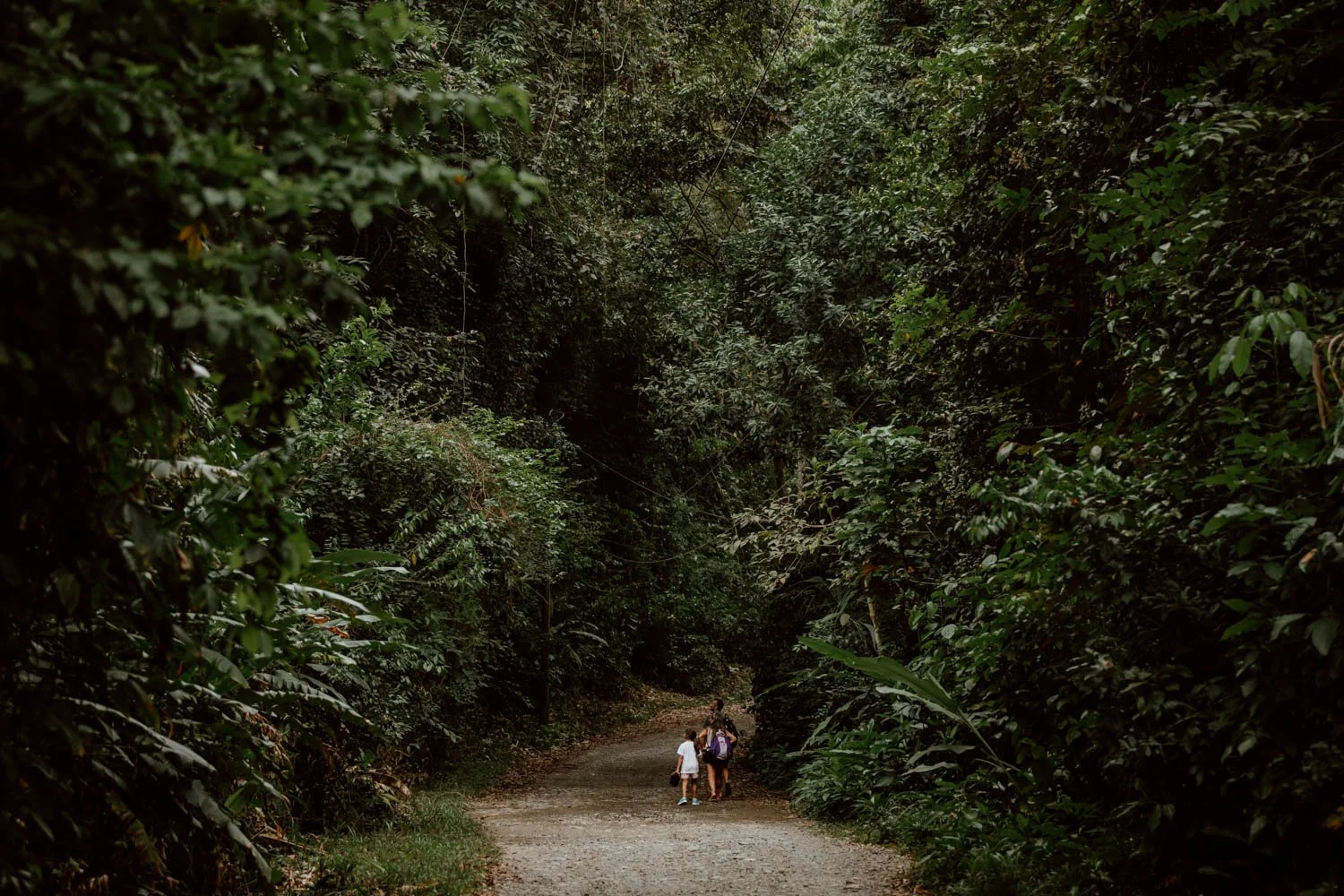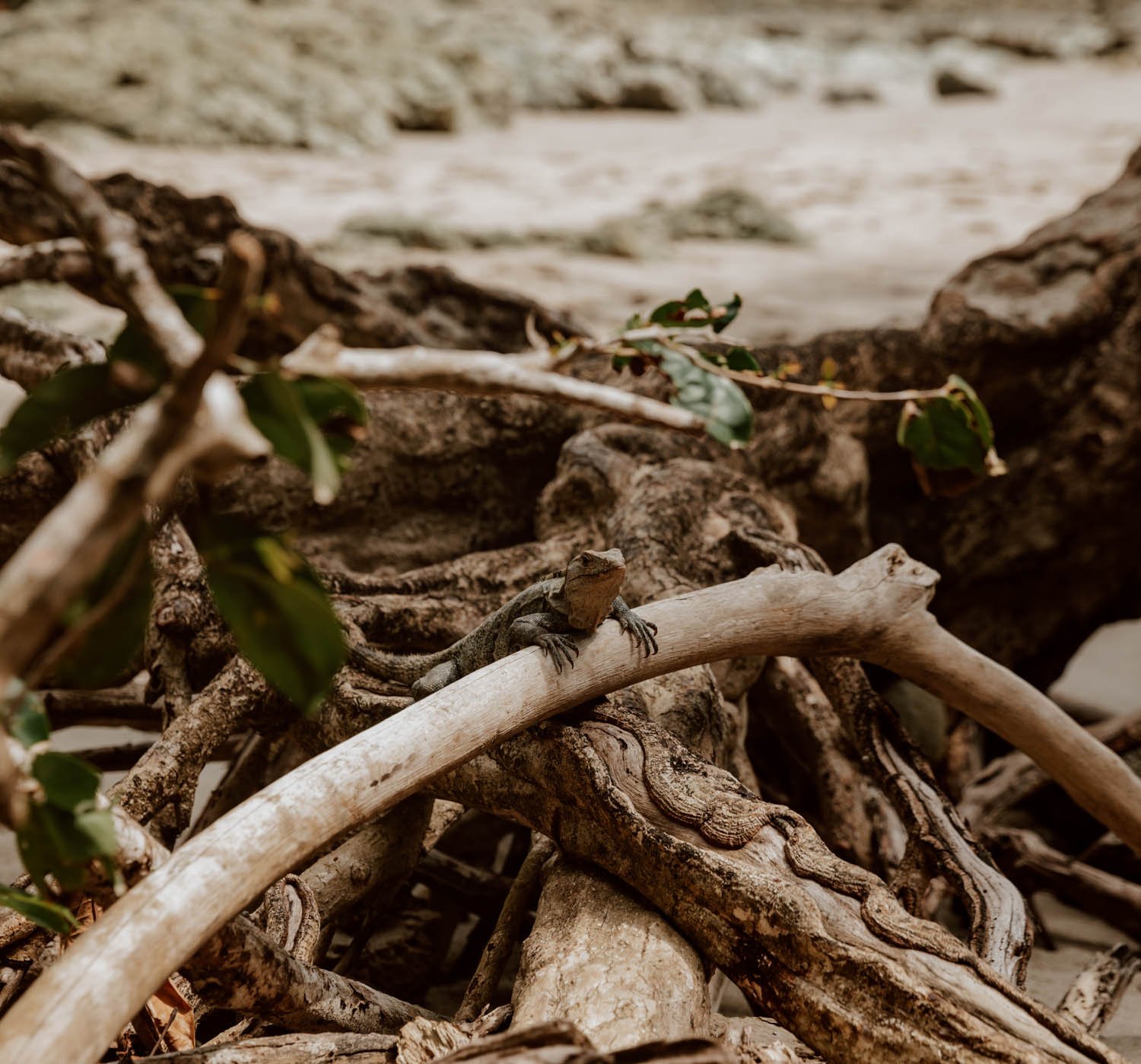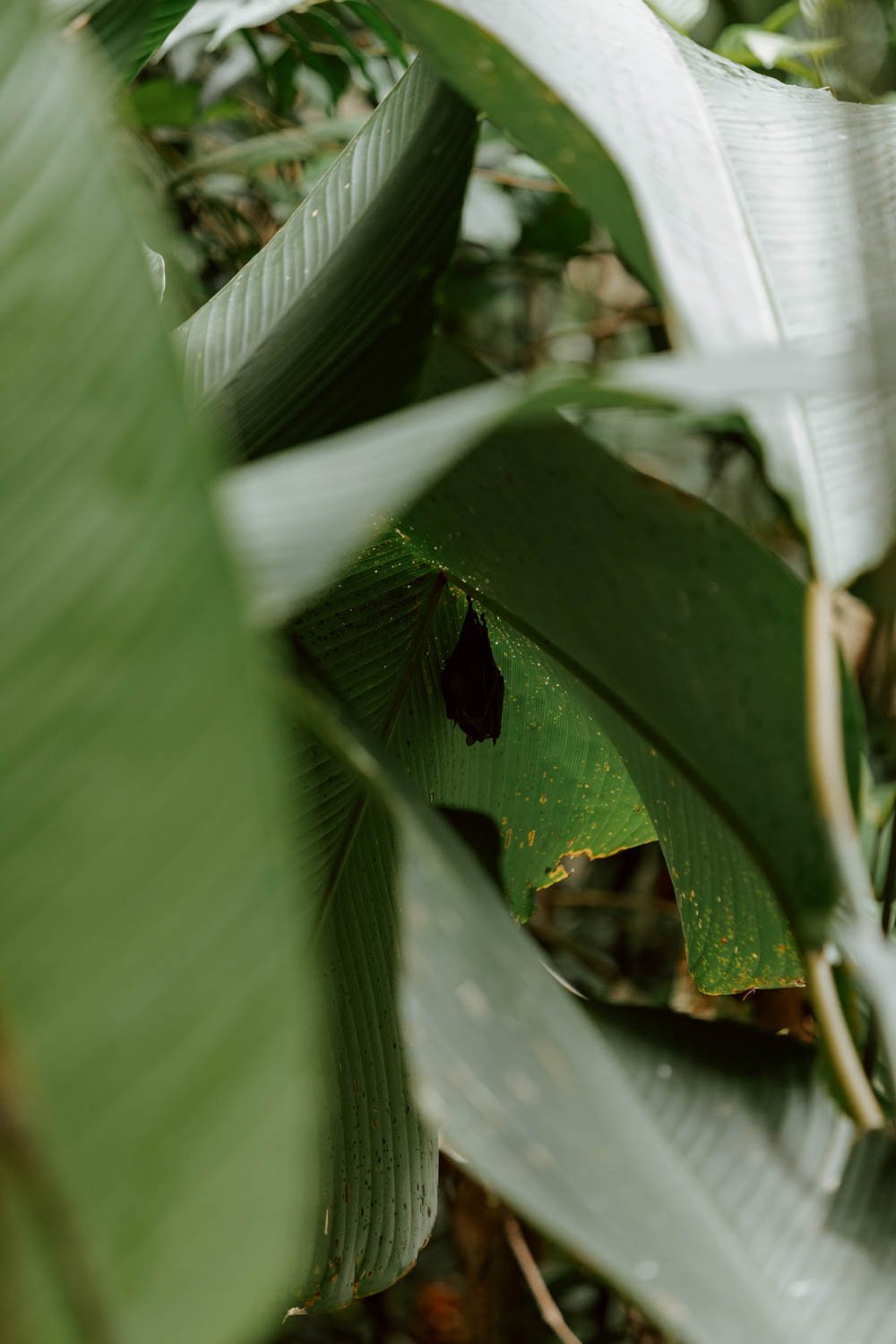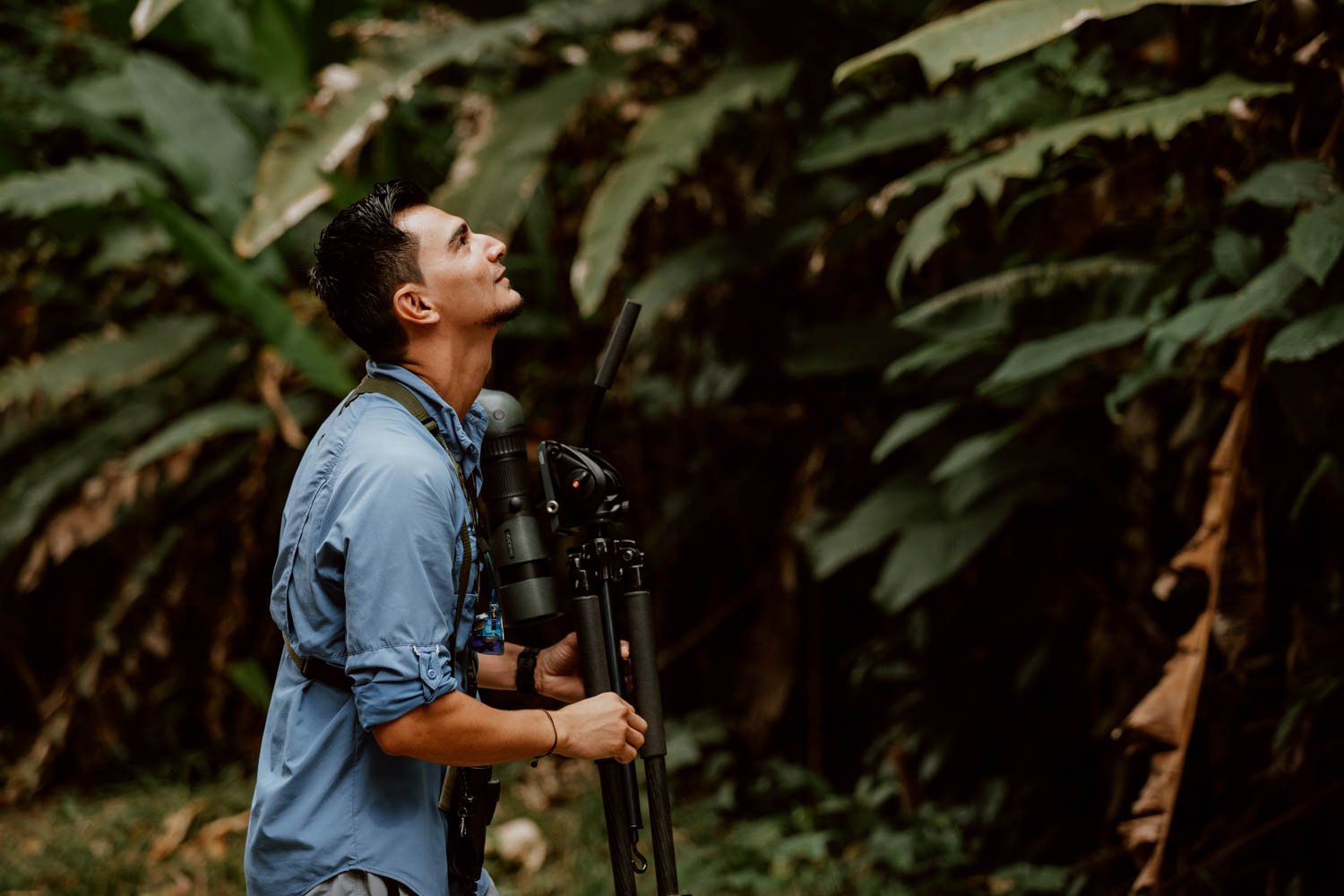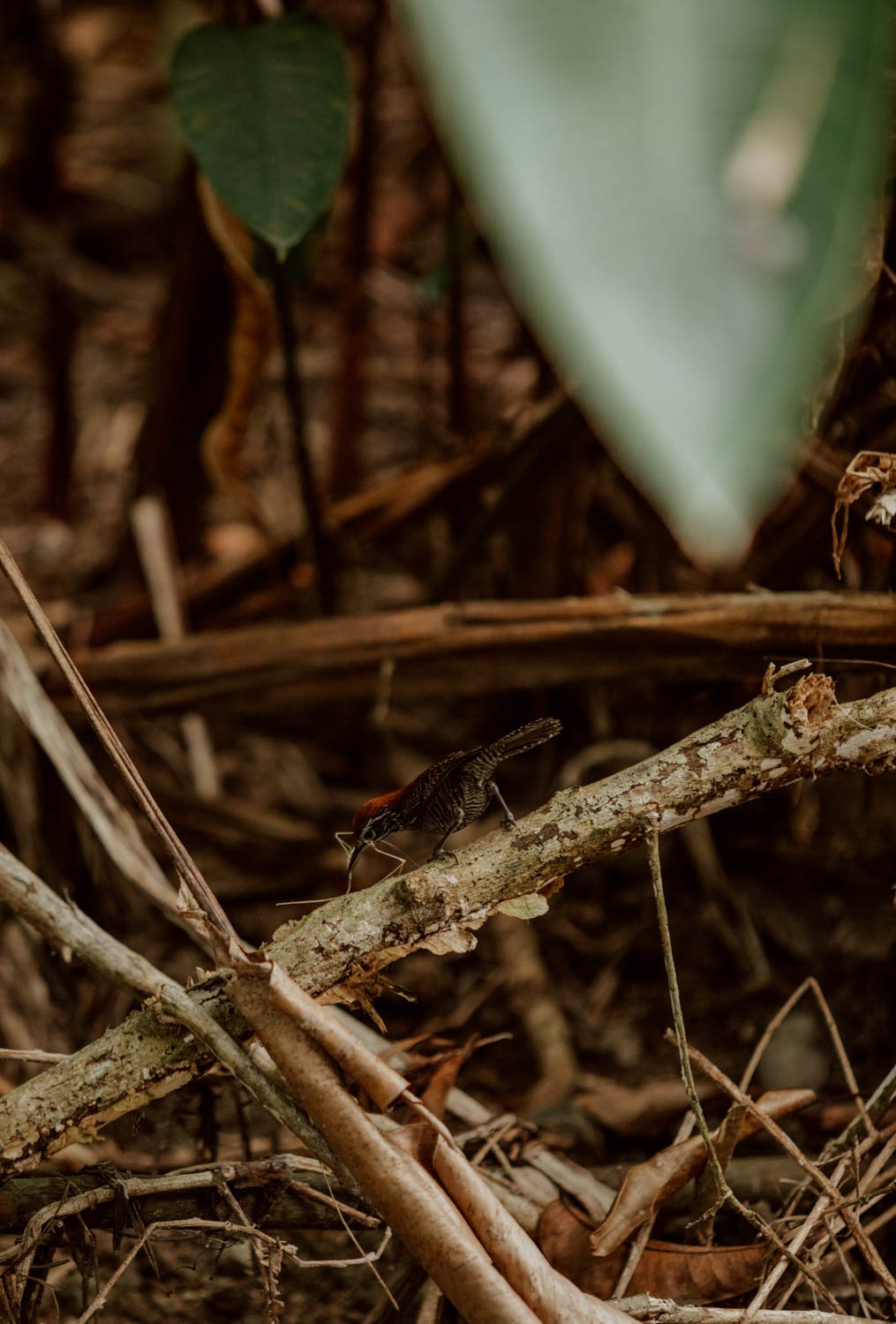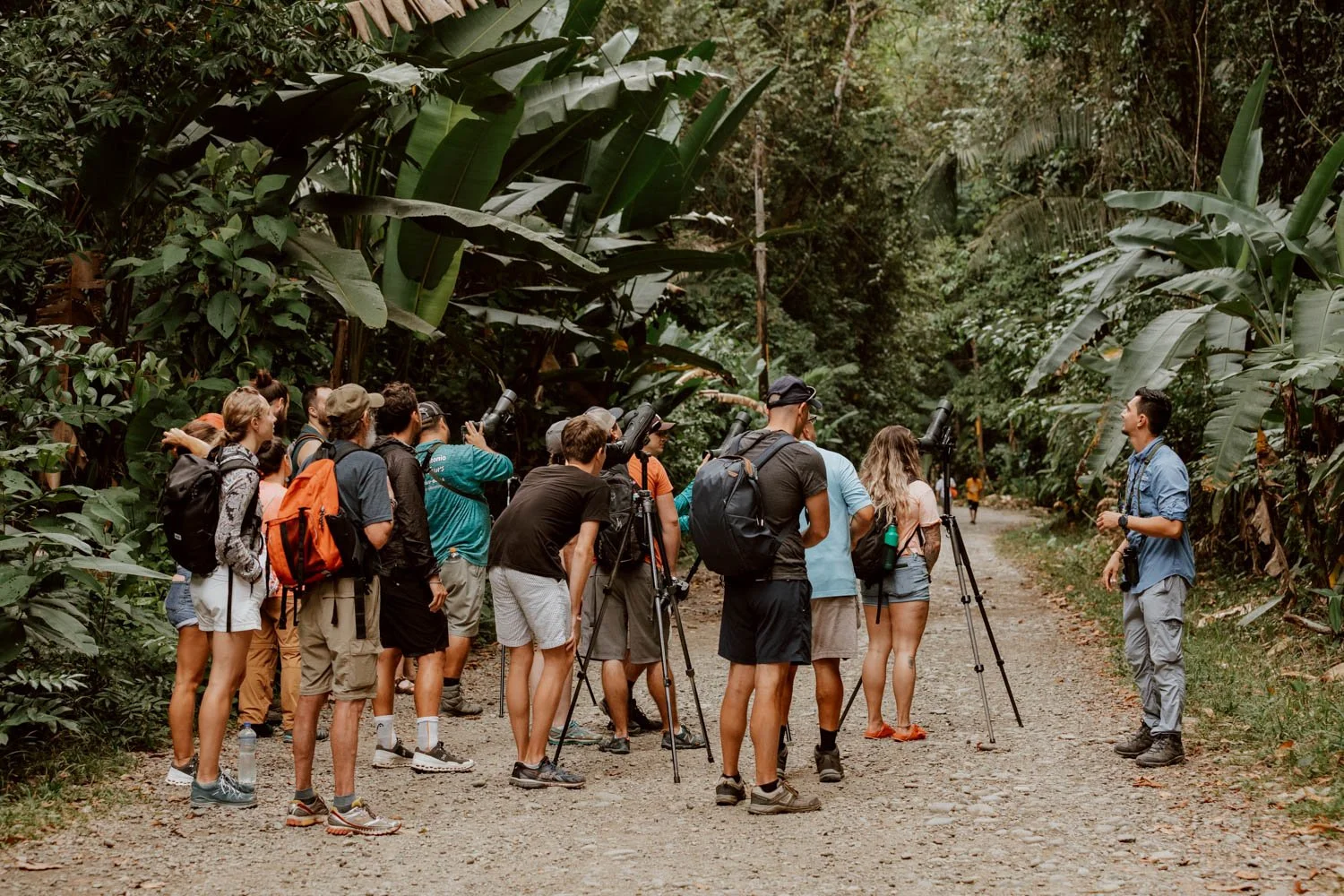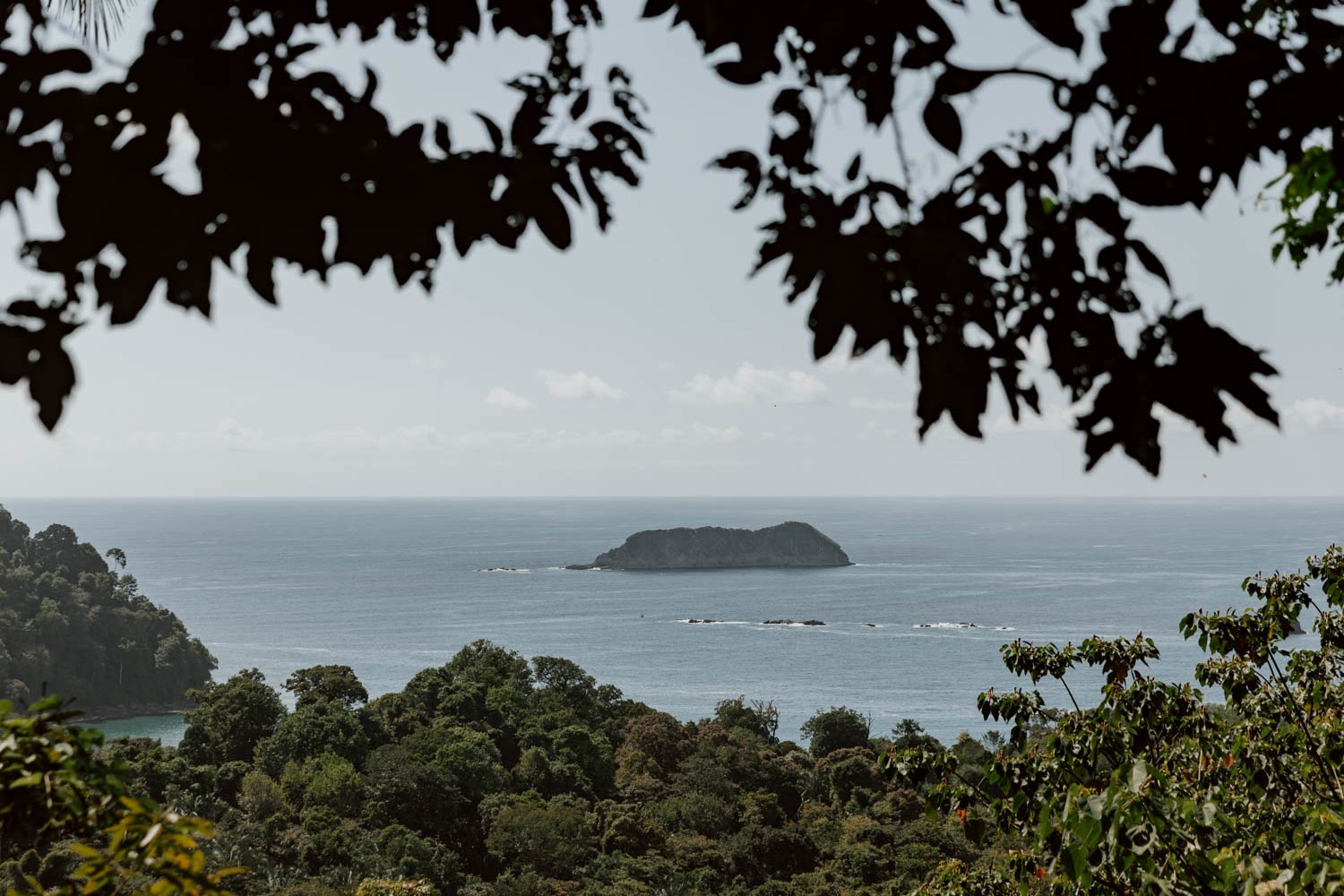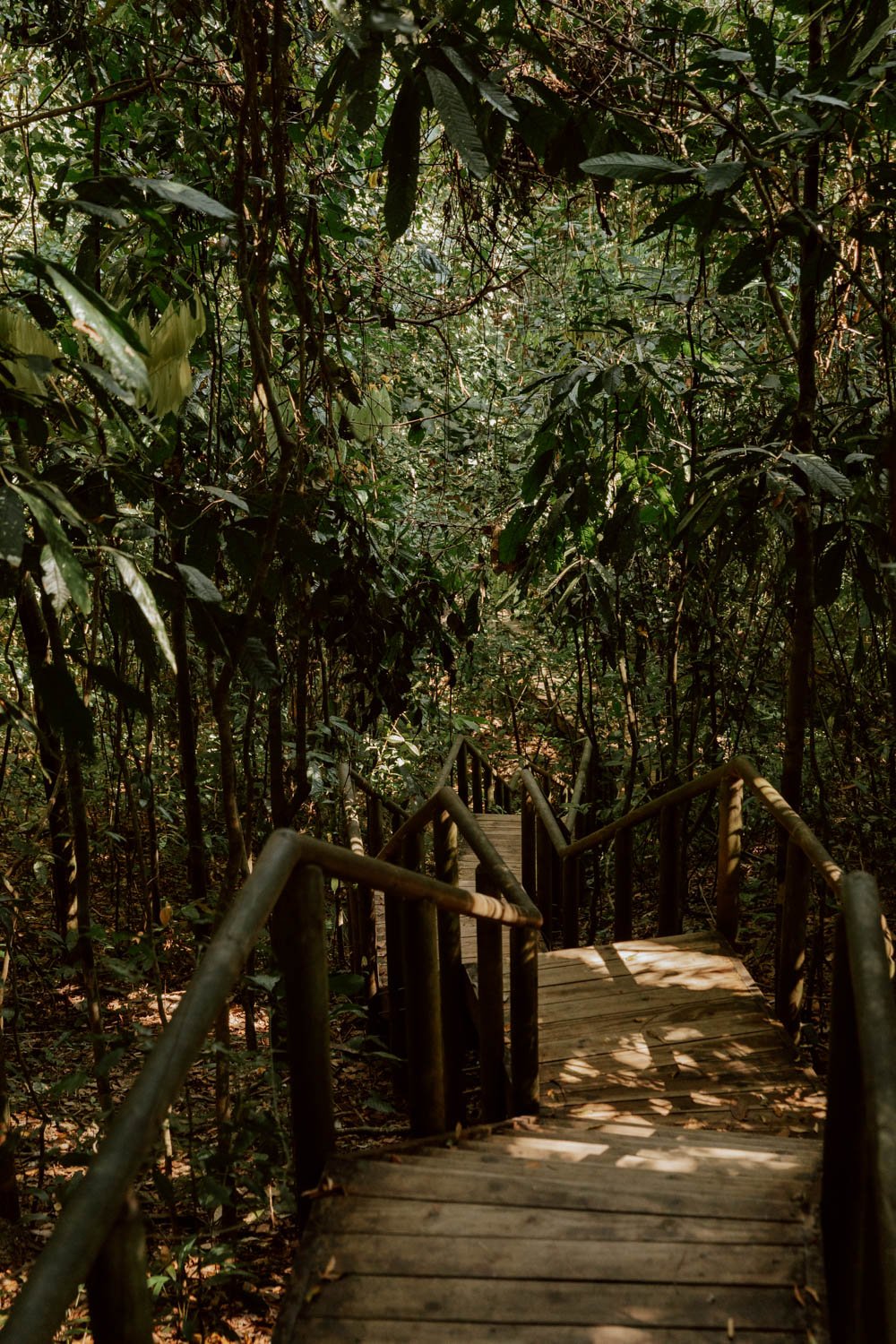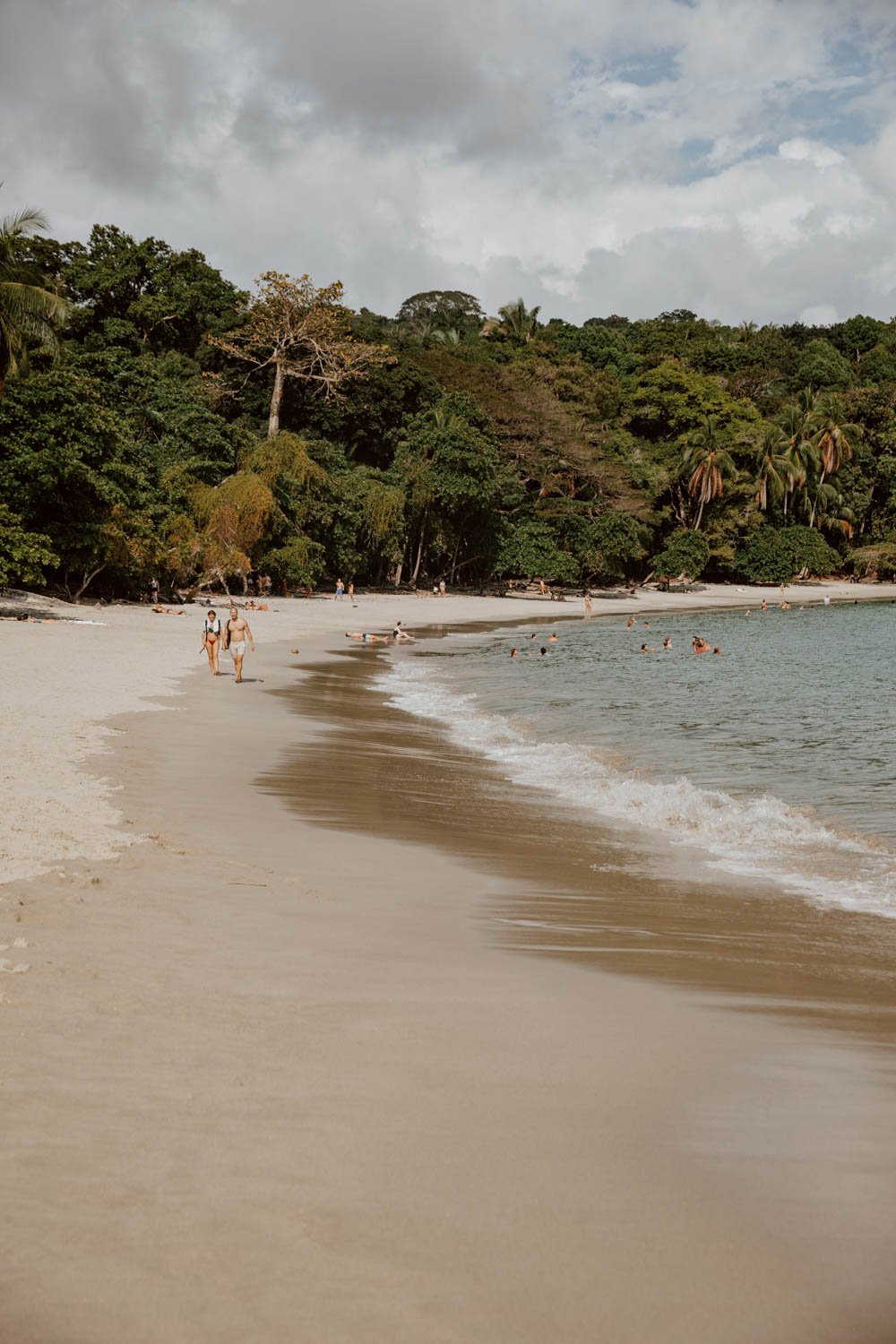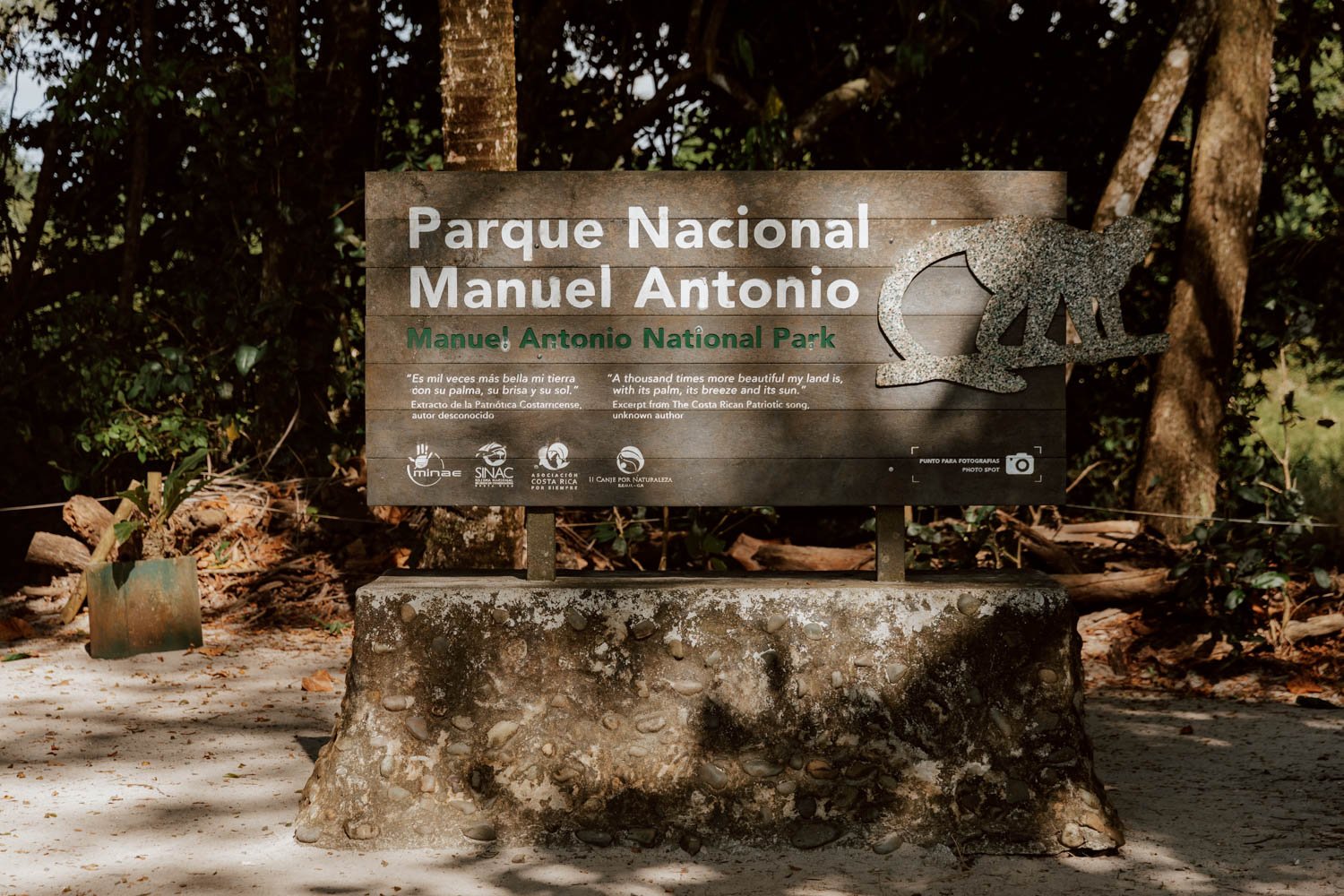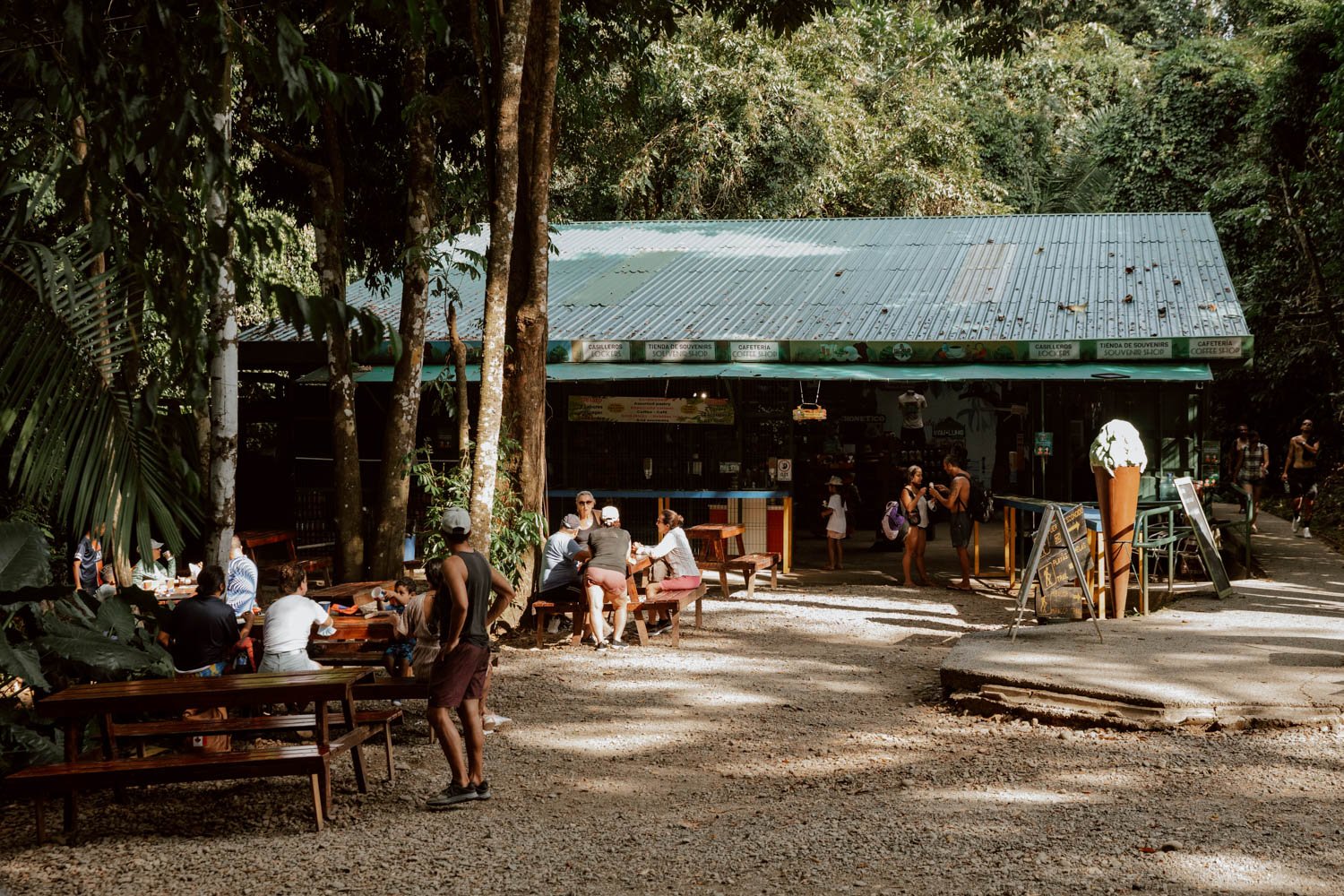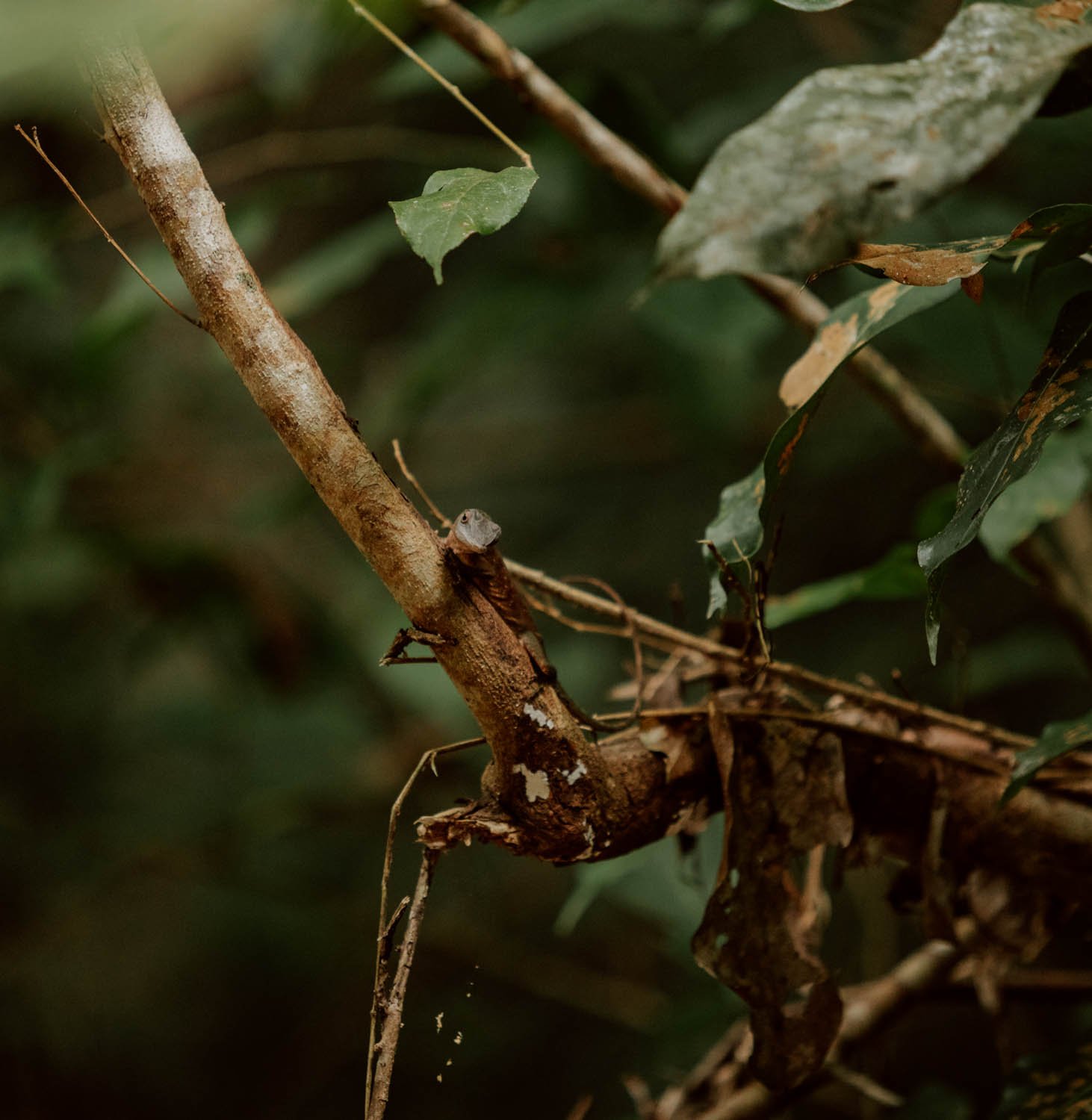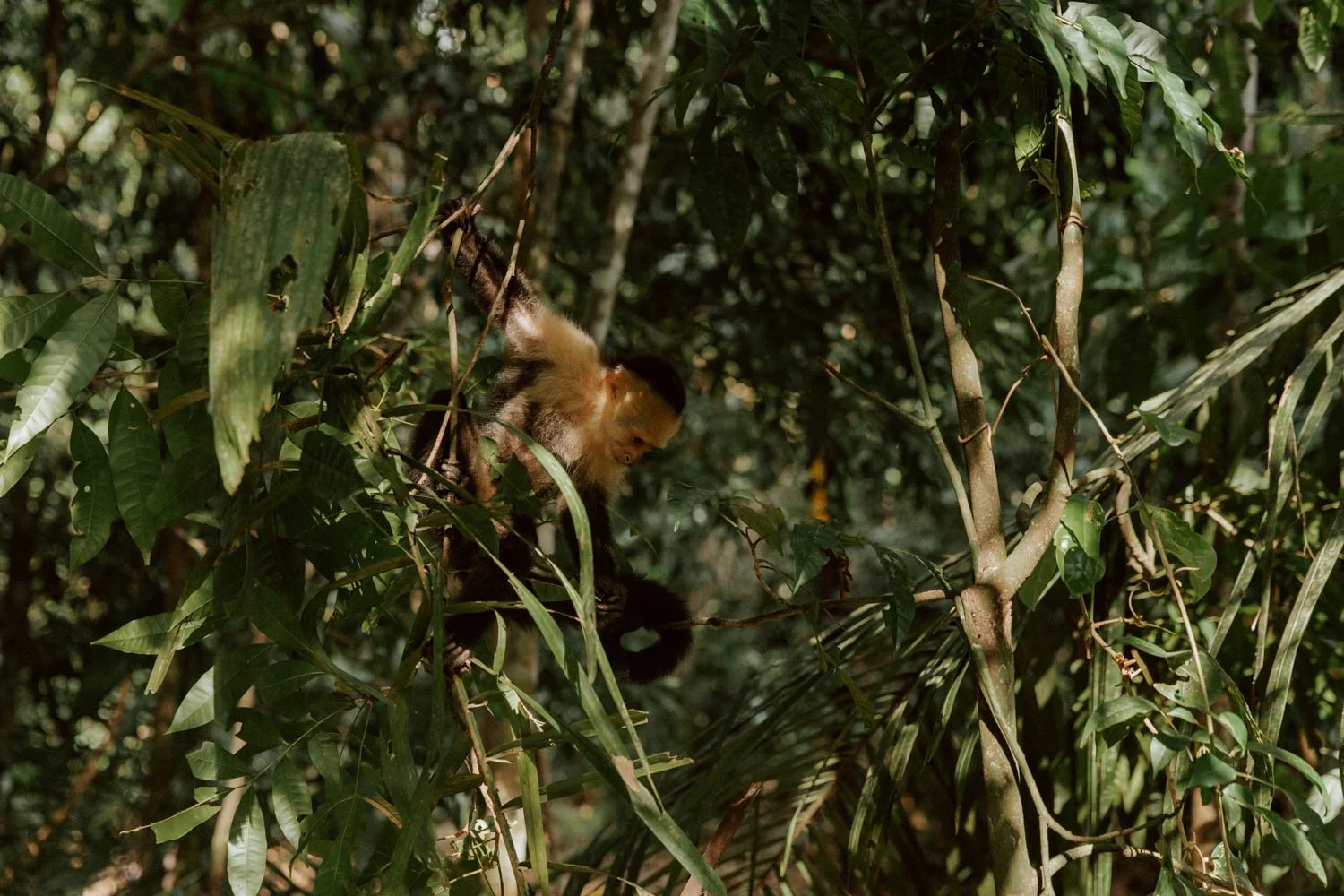One of Costa Rica’s most popular sights, knowing the ins and outs of visiting Manuel Antonio National Park - before you get there - is essential to making the most of your time.
In this practical guide to visiting Manuel Antonio National Park we’ll cover all the essentials like finding a guide and buying tickets, our tips to avoid the crowds, and importantly, how to see more animals.
Updated December 2023
The smallest and most visited of Costa Rica's much-admired national park system, a single day in Manuel Antonio brings you straight to an abundance of the natural elements which convinced you to travel to the country in the first place.
Tropical forest. Monkeys. Trails. Paradise beaches. Birds. Reptiles. Mangroves. Butterflies. The ocean. And yes - a very, very good chance of seeing a sloth!
This is one of the most biodiverse places in Costa Rica - and therefore the world - with all animals being wild, free, and protected.
Nestled halfway between touristy Jaco and the beautiful Uvita, Manuel Antonio's convenient positioning and accessibility on the Pacific Coast also underpins its status as year-round fixture on most traveller's itineraries. This popularity, especially on a weekend, does however mean it can feel a little Disneyland-ish and overly busy, with homo sapiens the most visible and vociferous amongst all the resident species.
In this practical guide for travellers like you, we've shared our personal tips and honest insights to help you plan the best day possible at Manuel Antonio National Park. From advice on how to avoid the crowds, seeing more animals, saving a lot of money on guides & tickets, the best time of year to visit and a suggested route, we've also included essential information on what to bring, car park scams, transport connections and a definitive answer on whether you really need a guide to see the animals.
If you're a budget backpacker in Central America, we've also got clear advice on whether you should be visiting Manuel Antonio or not.
These are seven essential things to know before you visit Manuel Antonio National Park.
The essentials
/ Covers 16km2 of land and ocean
/ The park entrance listing is wrong on Google Maps - we’ve dropped a pin in the correct location for you here
/ Open 7am-4pm every day except Tuesdays
/ Tickets cost $18 USD for foreign adults, $5.65 for children under 12 and must be booked online & in advance
/ Visits can be done in a morning or afternoon, but a full day is best to make the most of the trails + beaches.
/ No accommodation or camping inside park, with access only permitted on foot.
/ A guide isn’t compulsory but really enriches the experience. This one has excellent reviews.
/ Lots of accommodation nearby but some quick recommendations are: Millennium Manuel Hotel, The Falls at Manuel Antonio, Selina is great for backpackers. Or take a looks at this incredible beachfront apartment.
You Have To Buy Your Manuel Antonio national park Tickets Online (and in advance)
Before moving onto wildlife spotting, walking trails, and secluded paradise beaches, a bit of brass tacks.
The only way to purchase your Manuel Antonio ticket is online and in advance: you cannot buy tickets at the entrance.
The correct website is Sistema Nacional de Areas de Conservación de Costa Rica (SINAC), the government’s park management system, and you can visit it here. Annoyingly, you have to set up a profile first, but it’s pretty self explanatory after you’ve taken care of that and selected ‘Parque Nacional Manuel Antonio’ from the drop down menu of ‘Wildlife Areas’.
Tickets are sold in 40-minute entry time slots beginning on the hour, with the earliest available from 7am - 7.40am, then 8am - 8.40am etc.
The current daily cap on visitor numbers is 1,200 per day*, with around 170 tickets available for each time slot - if you click on the blue 'availability' button it allows you to see remaining availability over the next three weeks for that specific time slot.
There are no ‘multiday’ or ‘multiple entry’ tickets available for purchase, with each ticket only allowing a single entry on the specified day.
If you already know which dates you’re visiting, then it makes sense to just go ahead and book your tickets today to grab the most convenient time slot.
By the way, the tickets prices are weird figures ($18.08 USD and $5.65) is because of the13% tax, which is usually added in addition in Costa Rica to the upfront costs.
Important Note // That daily cap that we mentioned above is actually much lower than it used to be - previously it was 3,000, before dropping to 2,100 in 2022, and then 1,200 in 2023.
This is great news for conservation, but less great for the unorganised traveller - a problem that has been compounded by tour companies buying up lots of tickets for the sole reason of being able to sell them to less organised travellers and a much inflated cost.
Indeed, one reader has let us know that even during low season, tickets were sold out days in advance, and they had no choice but to buy one off of a tour company for twice the price!
So, moral of the story? Even if you’re more of a fly-by-the-seat-of-your-pants sort of traveller, this is one time that it pays to b e a tad more prepared!
Stay Nearby & Arrive Early
For a multitude of reasons, it’s best to start your Manuel Antonio National Park visit early.
The crowds will be sparser, the beaches emptier, the temperature more amenable, the sounds of nature more prevalent, and you’ll have more time to explore and relax at your own pace.
In short, you’ll have a much better experience than if you arrive during peak heat, tours and crowds at 12 pm.
Further, the opening times are actually quite deceptive, with park wardens telling everyone to start leaving a good 30-45 minutes before the closing time. So, where it says the park ‘closes’ at 4pm, it actually means everyone has to be out of the park by 4pm!
So, although you could easily see lots in a half-day visit, if you want value for money or to enjoy everything on offer at your own, unhurried pace, then try to get an entry slot before the tours and day-trippers start to arrive en masse from 10am.
This is also a reason why it’s a good idea, when planning your Costa Rica itinerary, to consider a few nights based around Manuel Antonio rather than a day trip from Jaco (2 hours) or Uvita (1.5 hours). If you’ve got a rental car, then you could absolutely do it if you have an early enough start, but with public transport it’s not worth the hassle.
The steep hill and road which links Manuel Antonio to the town of Quepos (Google Maps) is lined with a large number of hotels, resorts, Airbnbs, and hostels, and there’s enough in this part of the country to keep you happily entertained for a few nights or longer.
At the end of this guide, we’ve curated our personal pick of the best accommodations near the national park to help you find the best for your travel style and budget - but if you’re looking for a quick recommendation, Millennium Manuel is an excellently rated hotel right next to the park, Selina is a great hostel option (albeit a couple of kilometres from Manuel Antonio) but if you’d prefer an your own space, check out this incredible beachfront apartment.
How to Get to Manuel Antonio National Park
Arriving By Bus
If travelling Costa Rica by bus, like we were, you’ll usually need to make your way to Quepos first. There is a direct San José to Manuel Antonio service (6am, 9am, 10.30am, 12pm, 1.15pm, 2.30 pm, 4.45pm and 7.30pm) as well as direct services to Quepos, but you may also be on a service to/from San José which will drop you off at the side of the Costanera Sur motorway, from where you should take a taxi into the town’s bus station (maps) in order to catch the local bus to Manuel Antonio or onward to your accommodation.
The best way to travel from Quepos and any accommodation on the hill to Manuel Antonio National Park is via the regular public bus, which picks up 20-30 minutes or so and covers the length of the 618 road. We’ve shared schedules, costs, stops, and tips in this post.
Arriving By Car
Due to there being no official car park, a notorious issue for visitors to Manuel Antonio is the car parking situation and associated scams. Speaking to a few travellers in the days following our visit, it was quite unbelievable how prominent and persuasive these were, so it’s something you absolutely need to be aware of in advance.
On arrival, you’ll either drive into the busy commercial strip behind Espadilla beach (maps) or the narrow road which leads to the Manuel Antonio entrance (maps) - the latter is the best option for parking and the one you should make a beeline for with you GPS. There are a couple of private car parks there which charge 4-5,000 colones for the whole day. On the approach, where the narrow road can be quite busy with pedestrians, there are guys who will wave you down and direct you accordingly.
There are other parking lots nearby on that commercial strip, but these are more of a walk away and also more closely associated with scams of people telling you it’s the official car park (it isn’t), insisting you buy your ticket from them (it’s not the ticket), hard selling their guide service (and then abandoning you), or turning more of a blind eye to vehicle theft.
Wherever you park, ensure you’ve got all your valuables with you and nothing appealing left in the open.
You Really Do Need A Wildlife Guide & A Telescope
The most common question in any hostel when a visit to Manuel Antonio comes up, and we’re happy to give you a definitive answer.
Here at Along Dusty Roads, we first travelled Latin America for two years on a budget of £15/day each and always prioritise being independent travellers. Though we now spend a bit more cash when on the road, especially on shorter trips, our travel style remains value-based and budget-savvy.
Therefore, we thought we wouldn’t bother with a guide for Manuel Antonio.
However, after our experience in Corcovado National Park the week prior, we immediately changed our minds and have zero regrets.
In short, if you want to see animals in Manuel Antonio - big or small, rare or common - you need to get a guide; it is almost impossible without one.
There are three reasons:
They know the spots and environments where the specific animals usually hang around.
To a man, they seem to have superhuman eyesight to spot them.
They carry a bloody big spotting scope (the actual name) which allows you to actually see the monkey, sloth, bat, bird, iguana, or toucan in incredible detail.
Without our guide Jeremias and his scope, we would not have been fortunate enough to gaze upon two-toed and three-toed sloths, howler monkeys up above, a nesting humming bird, bats, capuchins, and various reptiles. Amongst the leaves and to the naked, untrained eye, you just can’t see much at all - and we always felt bad when people would pass our group, trying to see what we were looking at in amazement.
The guide will also take photos / videos for you through this telescope, meaning anyone with a smartphone can get some great shots.
Now for the really important bit though: guides can be very expensive.
On the official park website, a place in a guided group of up to 15 people costs $70 USD per adult and $57 for kids aged 3-12, with an extra $10 per person in peak season.
Although that price includes your entry fee, it’s quite frankly ridiculous (and very Costa Rica).
Thankfully, Emily had the genius idea of digging around for an alternative option and discovered this two-hour guided tour with a certified guide for just £25 / $31.50 USD per person. Although it would be great if it lasted a tad longer, we can personally recommend it after our own positive experience and the amount of knowledge he had to back up his spotting ability. Note that the price doesn’t include your entry ticket, which you have to purchase separately.
Alternatively, this one is a tad cheaper and also has really excellent reviews.
There are also highly-rated, good value guides to book directly on Viator (here) and GetYourGuide (here).
Note that for all tours, you have to meet your guide at the park entrance - you cannot meet them further inside the park - so it’s important to sync up you ticket and arrival times with your tour times. Once the tour is ended, your guide will usually leave you by one of the beaches so that you’re free to carry on your explorations independently.
Although it’s recommended to book in advance, note that you can also find guides touting for business outside the entrance. We asked Jeremias about them, and he advised that if hiring a guide outside, just be sure to check their credentials very carefully and ideally pick one with a licence from the local area. In addition to the car parks, fake guides are also a common scam, so just use your common sense to avoid issues i.e. only get a guide near the entrance, not at a distant car park or street corner.
If you still DON’T want or think you can afford a guide, then we’d suggest that there’s little point visiting Manuel Antonio at all. If budget is the main decision, then it’s silly to pay $18 per person to access a few trails and have a beach day (beautiful as they are) - we saw lots of amazing animals out on our own walks, bike rides, and from various hostel balconies in Costa Rica as well as in other national parks, so you will have other chances! If the reason is because you think a guide isn’t necessary to see more animals, then please please heed our advice!
Travel Tip // Whichever tour you go with, please try and ensure it’s a smaller group size. This may not always be possible, but being in a group of 10+ people will give you far less time on the scope when there’s a sighting. We were really fortunate to only have a group with one other person but if money is no issue, we highly recommend going for a private tour.
THE BEACHES ARE STUNNING
A day here is not just about the animals though…
Even though we had committed a huge chunk of our Costa Rica budget on an overnight stay in Corcovado National Park the week prior, we couldn’t pass up the opportunity to visit such a heralded nature spot. According to SINCAC, the park protects 352 species of plants, 107 species of land mammals, 335 species of birds, 93 species of reptiles and 56 species of amphibians.
Quite a bit then.
The chance to spot and appreciate even a small percentage of this array was our core motivation for visiting the park. However, as the guided wildlife tours last less than two hours, it’s very difficult to spot much for your own two eyes, and the park is also home to several stunning beaches, we left with a distinctly different opinion of what the real Manuel Antonio experience actually constitutes.
Indeed, most locals come to Manuel Antonio specifically to enjoy a paradise beach day rather than anything to do with spotting sloths, underpinning the sense at times that this isn’t actually the wildlife / nature experience or connection some of you may be hoping for.
So, don’t arrive in the park kitted out for an intrepid jungle trek as this isn’t one. It’s paved pathways, wooden walkways and concreted clearances, and you’re definitely going to want to make the most of the foliage-lined sand and sea too. The three Manuel Antonio beaches in the park are:
Playa Manuel Antonio (maps) | The first you’ll arrive at and by far the most popular, this stunning beach (all powdery white sand and crystal clear waters) is closest to the bathroom/showers but becomes more crowded with families and groups as the day wears on.
Espadilla Sur (maps) | A short walk from Playa Manuel Antonio, this long stretch is equally stunning and feels quite wild. If the above becomes a bit too busy, then head over here in the afternoon for more space and solitude.
Playa Gemelas | The smallest and most secluded, it is actually composed of a secluded, twin coves. Around a 20-minute walk from the above two main beaches, Gamelas is always less crowded.
You can sit or paddle in shallow waters at each, but swimming further out is strongly advised against due to rip currents - especially at Playa Gemelas where it is particularly dangerous.
We’ve shared more about what to bring, facilities and amenities later in this post.
Follow The Trails
In addition to the main wildlife spotting trail and trails to the respective beaches, there are also several defined, interconnecting walking trails (senderos) that you can take yourself on to see monkeys and miradors. All of these are either paved, covered, or on wooden walkways, rather than dusty or muddy paths, and you’ll naturally cover several of them as you enter and exit or walk to/from beaches.
We recommend taking a photo of the main map as you enter, but we’ve provided an overview below of the salient info:
The Service Road / Entrada Principal (1km) | This wide, gravel pathway starts at the entrance/exit, providing the vehicle access for the park, and as such isn’t much too look at. However, it’s actually the best for wildlife spotting according to the guides and most tours go along this!
Mangrove Trail / Sendero El Manglar (500m) | Wooden walkways amongst the trees which take you past the mangrove swamps (vitally important for the environment), and lead to a shortcut to the far end of Playa Espadilla. However, most of you should stick on this until it joins up with The Sloth Trail.
The Sloth Trail / Sendero Perezoso (570m) | Not guaranteed to see one on this, but it’s a very pretty walkway. If you’re not going with a guide, then entering via the Mangrove and Sloth Trail is a prettier and more educational route than the service road, also very child-friendly and educational with lots of information signs about the flora & fauna. If you enter with a guide via the Service Road, then you should head for the exit along The Mangrove and The Sloth.
La Catarata / Sendero Catarata (670m) | Leads to a waterfall, but this was unfortunately closed during our visit.
Mirador Trail / Sendero Mirador (1km) |Quite a hard going trail up to two viewpoints, especially in hot weather, as it’s all up, up, and then up some more! The first viewpoint is actually the prettiest, but as you’ve come that far up it’s worth continuing to the final one.
Cathedral Point Trail / Sendero Punta La Cathedral (1.2km) | A circular loop, starting from the natural corridor which links Playas Manuel Antonio & Espadilla Sur. The signs are a bit confusing, meaning both ourselves and another couple actually walked the entire loop twice before realising (when we passed each other again!). When we visited, all the viewpoints were roped off and clearly had been in a state of disarray for some time, with broken planks of wood, overgrown plants, meaning we couldn't actually see the view anyway. Please let us know when/if they re-open. Should take you around 35-45 minutes.
Hidden Point Trail / Sendero Puerto Escondido (400m) | The trail was closed off at time of visiting but the images of the viewpoint we saw online makes us think we didn’t miss much.
Howler Monkey Trail / Sendero Los Congos (280m)| A short up-down that links the Mirador trail with Playas Gemelas and the Puerto Escondido trail. We didn't see or hear any howlers on it however.
Personally, we found some these trails quite underwhelming and only spotted a few monkeys and a coati. By all means do all them if you have the time and inclination though, and hopefully you’ll have some better luck with us!
Travel Tip // The main way to explore the park is on foot, and there are no buggies or jeeps to take people around. Travellers with mobility or accessibility issues should note that a full day here can involve quite a bit of walking, with the main entrance trail being a flat 1km one-way, and they will not be able to walk many of the above trails. However, the entrance / exit trail is wheelchair friendly, and we believe access to Playas Manuel Antonio & Espadilla Sur is also possible. Lastly, there is the option to request a special permit at the entrance to enter the park in a taxi.
It Can Get Very, Very Busy
As the most famous and visited of the 26 national parks in a country which is an incredibly popular travel and holiday destination, it shouldn’t come as a surprise that Manuel Antonio National Park becomes very, very busy.
We pride ourselves on sharing our honest perspective across our blog posts, and the truth is that there would be moments on the busiest days here where the park feels less like somewhere to come and see nature, and more like a holiday resort. Families on their way to/from the beach, crowds of people hanging around the restaurant in swimwear, a traffic jam of tour groups clustered around telescopes.
We entered at 7am and by about 1 or 2pm, it was a different place entirely.
So, that’s another reason why we recommend you trying to get here earlier to spot the animals when it’s quieter, less crowded, and not so hot or noisy in sections.
High season coincides with the dry season on the Pacific side, running from mid-November to early May, with the peak travel period falling in from mid-December to early January (which is also when Costa Ricans have holidays). Visiting outside these months will see numbers fall quite a bit and the weather will still be ideal, but there is an increase chance of the odd shower or two.
Whenever you visit, heading for a walk on the trails will always be bit quieter, and our guide advised that when it gets busy as more day-trippers arrive for the beach, it’s best to go find a spot on the less crowded Playa Espadilla Sur or Gemelas as far fewer locals go to them (he was correct).
Personally, we think that stricter visitor limits on daily visitor numbers would only be a good thing for the experience, the park, and the native wildlife.
Leave Your Food & Plastic, But Pack Your Swimsuit!
It’s forbidden to take any single-use plastic, cigarettes, or food inside Manuel Antonio National Park. And not try and get around this rule, as our bags were checked upon arrival.
In terms of having breakfast or lunch, you’ve got a few different options:
There’s one on-site restaurant inside the park, but it doesn’t serve proper meals. Instead it’s an underwhelming array of sandwiches, empanadas, salads, ice-creams and sweets etc*.
Alternatively, you can have breakfast before you enter at the two restaurants lining the street outside the entrance or at the nearby beachfront. If you’re arriving before 7am however, note that these don’t actually open until 6.45am, so you may wish arrange to meet your guide a little later if you’d like some sustenance. We turned up at Donde Alex at 6.30am, where the waiter kindly said we could have coffees and sit, with our traditional Tico breakfast ready for 6.50am, so we did actually manage to wolf down something before heading in.
Those of you arriving later in the day will be able to find something easily or breakfast at your accommodation.
There is the potential to leave the park for lunch, and then go back in. However, we haven’t personally done this and would recommend that you clarify if you can do this at the beginning of the day in order to save a wasted journey to / from the beaches to the entrance during peak heat. Please let us know in the comments if you do it successfully!
You are able to bring in drinks which aren’t in a plastic container and a refillable water bottle, with several water fountains in the park at which you can refill (the water is safe to drink). You should already be heading to Central America with a refillable water bottle in order to minimise single-use plastic consumption, but if you’re concerned about water quality, then please consider investing in these affordable travel filter water bottles (we’ve used them for four years all over the world and swear by them).
If you forget to empty your bag of some snacks, then you can sometimes leave it with the coconut ladies outside for a small fee and collect it later.
Also, when you’re finished, make sure to grab a fresh coconut from those same ladies at the exit for 500-1,000 colones (or go wild with a coco loco).
*We have read conflicting information about whether the kiosk / cafeteria is currently open after being temporarily shut earlier in 2023. If you visit and can let us know either way, we’d love to hear from you in the comments.
What To Bring to Manuel Antonio
Assuming you’re visiting on a day where it’s going to be dry and hot, the essentials to pack in a small backpack / bag are:
· Comfortable walking shoes - hiking shoes aren’t necessary for the trails, but trainers or walking sandals are a good idea. If you’re just planning on doing the main wildlife walk and then the beaches, you can actually get away with flip-flops or sandals.
· Refillable water bottle
· Beach towel / sarong + swimsuits + suncream + sunglasses
· A hat for shade, especially on the beach
Unfortunately you can’t bring big beach umbrellas into the park, and there’s not a huge amount of shaded areas at any of the three beaches. Surfboards and coolers are also not permitted, neither are large bags or backpacks.
In terms of facilities, there are large bathrooms, showers and changing rooms between the restaurant and Playa Manuel Antonio. We also spied lockers behind the restaurant which are charged for, but you could probably just put your own padlock on one.
Travel Tip // Read our post for tips on how to travel with less plastic.
Respect The Trail & Every Single Animal
It should go without saying, but it’s incumbent on all of us to preserve the status, biodiversity, and biosecurity of each place we visit, even when it’s got a protected status like this park.
Be a responsible traveller, and don’t go off the marked trails to get a better view or make the day more adventurous. This isn’t just for the preservation and protection of the flora and fauna, but for your own safety too.
In and around the park, it’s not unusual for the wild animals to cross your path. This could be a large iguana on the beach, a coati mooching around, or the gang of cheeky capuchin monkeys that have developed a habit for stealing food in and around the restaurant area. The latter unfortunately transforms large swathes of people into idiots who get super close to try and take photos, feed, intimidate or even touch the monkeys or other wild animals.
It makes us so sad.
Please do not be one of these people.
Don’t feed, don’t touch, don’t antagonise, or intimidate - and remember that if a capuchin is above you, they do enjoy throwing poo and wee around…)
Wildlife isn’t entertainment and their habitats aren’t for us to encroach, so if you see someone breaching any of the above (which you will), feel free to politely bollock them.
We would also like to see more ranger presence in and around the restaurant to monitor and educate behaviour, since this is such a clear issue.
Where To Stay Manuel Antonio National Park
As we’ve mentioned, there’s no accommodation in Manuel Antonio park, but there’s a HUGE selection in the vicinity.
Much of this is concentrated along the entirety of the steep 6km hill and road which separates the town of Quepos from the national park, with most accommodation and restaurants found in and around the tourist hub at its peak, about 3km from the park entrance. This resort development area is also called ‘Manuel Antonio’, and the shared names understandably cause some confusion for first-time visitors or people trying to find somewhere to stay in or near the park!
Have no doubt that much of this stretch is very developed and touristy, with big resorts, fancy hotels, Airbnbs, restaurants, shops, and bars all the way along the road - the closer you get to Quepos though, the quieter and cheaper it gets.
The regular Quepos-Manuel Antonio bus conveniently drives up and down at 20-30 minute intervals each day, and will bring most of you reading this to and from the park and your accommodation.
Those of you on a budget, or looking to have more local life on your doorstop, can also consider staying in Quepos itself, which has a bunch of restaurants and bars, good public transport links for Manuel Antonio and elsewhere, as well all the vibes of a small Costa Rican town.
We’ve done the hard work for you and shared our recommendations for the best place to stay for your travel style and budget:
Hotels & Guesthouses
San Bada Hotel | This fairly generic (albeit very comfortable) 4* hotel isn’t quite our cup of tea but has good reviews and is just a two minute walk from the entrance to Manuel Antonio National Park. Ideal if you’re only visiting the area for a couple of days and want to be in close proximity. Find out more here.
La Posada Jungle Hotel, Millennium Manuel and Hotel Manuel Antonio are also excellently located just a couple of minutes walk from the park, both at a good price point. If on a budget but still value proximity, be sure to consider Villa Prats (definitely nothing fancy, but cheap by Costa Rican standards).
Tico Tico Villas | Cool, quirky and fun, Tico Tico Villas is an adults-only space offering studios and one bedroom apartments 1.5 miles from the park. Colourful, bright and airy, the price point shows that you can get more for your money if a little further towards Quepos. Find out more here.
If being a little way from the park doesn’t bother you, be sure to check out Hotel Plaza Yara too.
The Falls at Manuel Antonio | Another great mid-range option (doubles from $110 USD per night), The Falls offers good sized, unfussy, comfortable rooms. The facilities are decent, and it’s just an 11 minute walk to the beach. Find out more here.
Hotel Costa Verde | One of the more unique hotels in Manuel Antonio, the boutique Costa Verde offers large, beautiful rooms, with stunning views (think the sea, the rainforest and wild animals) - they’ve even got a suite in a Boeing fuselage! Do note that it’s a 10-15 minute walk to the park. Find out more here.
Arenas del Mar | Wrapped in the rainforest, this is the only luxury resort in Manuel Antonio which offers a beachfront location (majority of rooms come with balcony overlooking the ocean). Large elegant rooms with clean lines and excellent facilities. The facilities are excellent and include a hamman and infinity pool. Find out more here.
Other highly-rated 5* boutique hotels include the adults-only Gaia Hotel, Parador Resort and Makanda by the Sea.
Si Como No | Sitting atop a hillside in Manuel Antonio, the popular Si Como No seamlessly combines luxury and sustainability, their eco-rooms overlooking the jungle and the ocean beyond. It also functions as an animal refuge, so expect to see monkeys, birds and even sloths from your balcony. Find out more here.
Hostels
Selina | We’ve had mixed experiences with Selina properties, but in most cases they are a great options for solo backpackers and digital nomads - the Selina in Manuel Antonio is no exceptions. Good value when compared with hotels in the area, they also offer a large pool, good communal areas, a variety of decent rooms, restaurant and shared kitchen. Find out more here.
Hostel Plinio | Located just under a mile from Quepos, this oversized treehouse of a hostel has a huge number of great reviews. Surrounded by jungle, the rooms are large and airy (including the dorms), the communal areas many and the pool perfect. Guest speak highly of the free breakfast. Find out more here.
Wide Mouth Frog | This new hostel in the centre of Quepos is a great option for those who prefer a more urban location. The dorms are a little on the small side, but the common areas are great and it has a large pool. Check availability and prices here.
Airbnbs & Apartments
Villas En Sueño | This cute little cabin with a large balcony overlooking the jungle is where we stayed for a few days to visit Manuel Antonio. Situated only a few minutes walk from Quepos, and on the bus route to the national park, for us the location was perfect. Part of a surf school, they’re able to arrange lessons, and a free - and excellent - breakfast is provided each morning. Highly recommend. Find out more here.
A similar and super popular option is this one, located within a lovely little guesthouse.
Oceanview Studio | This little studio in the heart of Manuel Antonio village is ideal for a young couple (or an older couple who don’t mind having to climb quite a few stairs to reach it). Small but perfectly formed, the facilities are great and it has a balcony with sea views. Also excellently priced. Check availability here.
Other studios definitely worth taking a look at include these two jungle studio: studio one and studio two.
Mi Casita | A modern, brand new modern one-bedroom, for those that appreciate a bit of luxury (but still want their own space). Features a plunge pool and large balcony with views out of the forest canopy and sea beyond. It’s also on a ‘wildlife corridor’ so expect lots of animal sightings! Find out more here.
Coquitos | Cheap and cheerful, this one bedroom apartment is perfect for those that just want a crash-pad near the park. Find further information here.
Manuel Antonio Cabin | One of two eco wooden cabins on Finca Los Mangos, halfway between Quepos and Manuel Antonio. Pool, beautiful gardens and isolated vibes - just 200m off of main road. Find out more here.
Villa Capuchin | This stunning three bedroom property is ideal for families wanting contemporary luxury and incredible views. Also has wonderful pool area. Find out more here.
You should probably look at this gorgeous two-bed while you’re at it - it’s one of our favourites. Oh, and Casa Neruda has truly incredible views!
Villa Fuego | If beachfront sounds like a good idea to you, you aboslutely must check out good-sized two bedroom apartment - the private garden area even has its own plunge pool Find out more here.
Beautiful Views | The inside of this property one-bedroom property is light, bright and has lots of space (plus lovely handmade wooden furniture), but the real draw is the incredible terrace area with breathtaking views and infinity pool. Also includes breakfast, maid and concierge service. Find out more here.
Where To Next?
How to Get From Quepos to Manuel Antonio (And Vice Versa)
13 Wonderful Things To Do in Uvita
How to Get From San Jose to Manuel Antonio (published soon)
A Short Guide to Marino Ballena National Park
A Traveller’s Guide to San Jose
How to Visit Nauyaca Waterfalls | An Unmissable Place in Costa Rica




